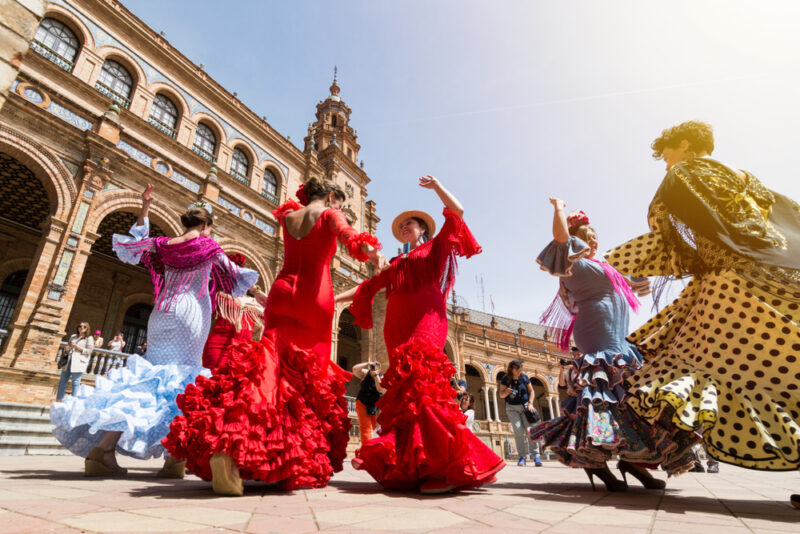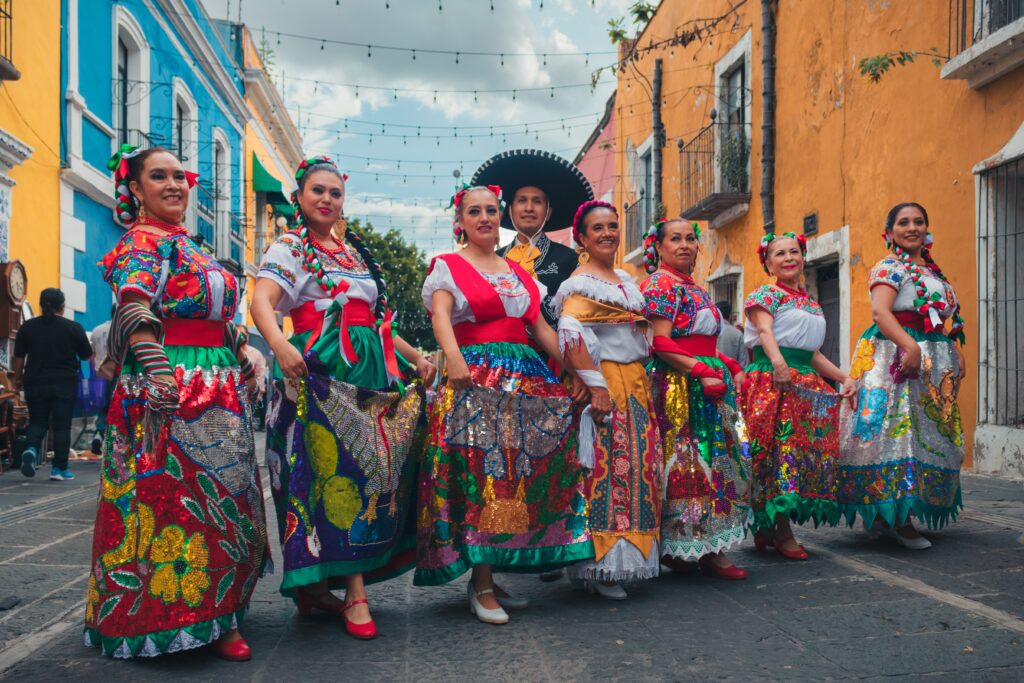
The Fascinating History of Spanish
Have you ever wondered where, exactly, Spanish comes from?
And how much did Spanish evolve over time? How is the Spanish we speak today different from the language in the past?
It turns out the Spanish we now know and love is the result of thousands of years of language development and cultural influences.
Join me on a journey to learn about the origin and history of Spanish and its evolution to today’s varieties of the language.
Contents
Download: This blog post is available as a convenient and portable PDF that you can take anywhere. Click here to get a copy. (Download)
The History of Spanish
1. The Roots of Spanish
Time period: 3400 – 200 BCE
Linguists theorize that a common mother language called Proto-Indo-European was spoken until around 3,400 BCE. This language, as the name implies, was spoken over a vast geographical area from India to Europe.
Since this ancient language was never written or recorded, we don’t know much about it, although linguists have recreated some words and sounds based on theoretically informed guesses.
But we do know that from its humble beginnings near the Black Sea, Indo-European was spread far and wide as groups of people fanned out across Europe and Asia.
Over time, languages evolved and branched out into Anatolian, Indo-Iranian, Greek, Italic, Celtic, Germanic, Armenian, Tocharian, Balto-Slavic and Albanian. Linguist Mark Damen explores one aspect of this evolution over the years in a TEDx talk here:
But we’re here for the history of Spanish, we’re focusing on the Italic branch of the Indo-European languages because it’s from that branch that we eventually got to Latin. And Spanish is firmly rooted in Latin: Vulgar Latin to be specific.
2. Spanish Emerges From Vulgar Latin
Time period: 200 BCE – 710 AD
As the Romans spread out across Europe, they settled in the Iberian Peninsula, bringing their Latin language with them. During these hundreds of years of occupation, the locals had to find a way to communicate with the Roman newcomers.
Thus, a language was born: Spanish originated on the Iberian Peninsula and developed from Vulgar Latin, which is the spoken form of Latin.
If you’re interested in the differences between classic and vulgar Latin, NativeLang has an interesting exploration of the sounds in the video below:
3. Spanish Is Strongly Influenced by Arabic
Time period: 710 – 1450 AD
Just when Spanish was getting comfortable on the Iberian Peninsula, something groundbreaking happened. The Romans were out and Spain was overtaken by Muslim Moors from the south. In fact, they continued to rule the peninsula for around 800 years.
During this time, not only did the Moors build incredible buildings in Spain like the Alhambra, a but vast array of Arabic words were incorporated into Spanish. In fact, about 4,000 modern Spanish words are Arabic in origin!
You can hear how similar Arabic and Spanish are in this video:
4. The Castilian Spanish Dialect Emerges
Time period: 1200s
As the languages in the area mixed together, dialects began to take shape within the spoken language.
Around the end of the 11th century, the Castilian dialect developed in northern Spain. This is the earliest point where we could hear the origins of modern Spanish.
What started as a local dialect spread and gained a foothold when the kingdoms of Castile, Leon and Aragon joined together to form the beginnings of Spain in the late 15th century, and in 1492, Castilian became the region’s official language.
With this newly widespread use, literature began to emerge from the area. People started to write down the tales that were previously spread through oral storytelling, further evolving and refining the language.
Other literature began to be translated into Castilian, as well. A surge of written language is often a sign of a high point for a society, and Spain was no exception.
In Charles E. Chapman’s “A History of Spain,” we learn that there was a large intellectual surge leading up to the end of the 15th century.
To this day, Castilian Spanish remains the official language of the country, although other varieties of Spanish are also spoken.
5. Spanish Is Introduced in the Americas

Time period: 1490s – 1830s
You may be wondering how Spanish ended up being spoken so far from the Iberian Peninsula in Latin and South America. The answer is exploration and colonialism.
The journey of the language across the Atlantic is largely thanks to an Italian (or maybe Portuguese) explorer whose name you might recognize—Christopher Columbus.
Starting with his voyage in 1492, Columbus traveled on behalf of Spain (speaking Castilian Spanish) to the Americas four times.
He and his crews brought the language to many places, including the Bahamian islands, Trinidad, the South American mainland, Panama, present-day Haiti and the Dominican Republic.
And he wasn’t the only Spanish explorer who explored the Americas: Spain’s Juan Ponce de León also made several trips starting in 1513 to Florida. In fact, Spanish and English co-existed in North America as the main languages for over 400 years.
All this exploration by the Spanish led to the establishment of several Spanish-speaking colonies in present-day Florida and California.
6. Latin American Spanish Develops
Time period: 1500s – present
Languages don’t live in isolation, and Spanish continued to evolve after it arrived in the Americas, and long after the Spanish explorers had left.
Castilian Spanish may have arrived in its pure, original form to the Americas, but it didn’t remain that way: Dialects emerged, and Latin American Spanish evolved. There are unique versions of Spanish spoken in Peru, Chile, Argentina, and Mexico—in fact, there are 12 dialects of Spanish just in South America.
Even today, depending on where you go, you’ll hear differences in the accent and vocabulary of the language, sometimes subtle and sometimes pretty drastic, as you can see in the following video:
Over time, the sounds and vocabulary of Latin American Spanish became pretty different from those of Castilian Spanish, as you can hear by comparing the wonderful varieties of Latin American Spanish in the previous video to Alberto Jorrin’s pitch perfect Castilian pronunciation here:
If you want more insight on the differences between Castilian and Latin American Spanish, FluentU has many examples of these versions of Spanish in its vast video library, showing how real people around the world use Spanish.
FluentU takes authentic videos—like music videos, movie trailers, news and inspiring talks—and turns them into personalized language learning lessons.
You can try FluentU for free for 2 weeks. Check out the website or download the iOS app or Android app.
P.S. Click here to take advantage of our current sale! (Expires at the end of this month.)

So, that’s a concise overview of how Spanish came to be! If you also learn well by watching videos, this informative TED Ed video might help cement your new knowledge on the subject. It traces the history of Spanish from the 3rd century BCE in Iberia to the present day:
The Spanish Language Today
Spanish Language Facts
Today, Spanish is the most widely spoken Romance language on Earth. In fact, it’s the native language to almost 490 million people in 20 countries. When you count those who use it as a second language, the total goes up to nearly 600 million speakers.
Spanish is also used widely in countries where Spanish isn’t an official language. The United States is a prime example of a place where Spanish is used extensively despite not being one of the country’s official languages. Nearly 45 million Americans have Spanish as their native tongue.
Spanish is also considered the second world language in international communication and the third world language in politics, economics and culture.
For more interesting facts about the Spanish language, visit this post:
20 Spanish Facts that May Surprise You | FluentU Spanish Blog
Looking to learn more about the Spanish language? Then check out this post and be amazed at these 20 facts about Spanish! How many people speak Spanish? Who’s “in charge”…
Castilian Spanish and Latin American Spanish
Castilian Spanish—castellano in Spanish—is spoken predominantly in Spain. Though Castilian is mutually intelligible with other Spanish varieties, there are some pronunciation differences, and a few vocabulary differences.
In Spain, they have a pronunciation feature called the seseo, which basically means that the <c/s> sound found in words like el centro (the city center) or Barcelona are more like a <th> sound.
In Spain you drive un coche (a car) while in South America, you ride in un carro (a car).
In Spain, the usted (you, formal) form is reserved for officials and elders, while in Argentina, almost everyone you know is usted (you, formal) and the tú (you, informal) is hardly ever used.
The Royal Spanish Academy
Originally founded in 1713 to preserve and protect the Spanish language, the Real Academia Española (Royal Spanish Academy) still operates today, recording and guiding the language when new words are required.
Although there are linguistic variations between the Spanish-speaking countries and territories, one of the Academy’s main purposes is to maintain a certain standard and level of uniformity within the various varieties of the language.
The Academy engages in academic activity and releases a dictionary that’s updated every few years, but this doesn’t mean the Academy resists all change. They know that Spanish is the result of linguistic evolution, and it will continue to change as time moves on, as new words are coined, and as new regional accents develop.
FAQs About Spanish
When Was Spanish First Spoken?
Spanish, which emerged from Indo-European’s Italic branch, was first spoken in the northern Iberian Peninsula. The earliest textual proof of Spanish is from documents written in the 9th century, found in and around Toledo in Spain, but it’s likely the language was spoken a couple hundred years before this. Most linguists agree that the language was standardized by the 13th century.
Where Did the Spanish Language Originally Come From?
Spanish emerged from a combination of Indo-European languages that came to the Iberian Peninsula via migrants from the Black Sea region, and the introduction of Vulgar Latin, the spoken language of the colonizing Romans in the territory that is modern day Spain.
What Did They Speak in Spain Before Spanish?
Before occupation by the Romans, people in Spain spoke a wide variety of languages, most of which emerged from Indo-European languages from the Black Sea region. The major language of indigenous Iberians was known as Iberian, which has little in common with modern Spanish. Some people also spoke non-related languages such as Basque.
Who Speaks “Original” Spanish?
Most linguists today say the people of northern and central Spain speak “original” Spanish, which is where the Castilian variety of the language developed. Often called European Spanish, this variety is also the official language of Spain.
In short, Spanish is like una hermosa mariposa (a gorgeous butterfly).
Through various processes of change and transformation, the language that we know and love emerged, in all its glorious colors and variations.
It spread its wings and flew—and now calls the global community its home!
easyleadbox id=”56d438e6-6cf8-11ea-bc45-82eb1e393285″]
And One More Thing…
If you've made it this far that means you probably enjoy learning Spanish with engaging material and will then love FluentU.
Other sites use scripted content. FluentU uses a natural approach that helps you ease into the Spanish language and culture over time. You’ll learn Spanish as it’s actually spoken by real people.
FluentU has a wide variety of videos, as you can see here:

FluentU brings native videos within reach with interactive transcripts. You can tap on any word to look it up instantly. Every definition has examples that have been written to help you understand how the word is used. If you see an interesting word you don’t know, you can add it to a vocab list.

Review a complete interactive transcript under the Dialogue tab, and find words and phrases listed under Vocab.

Learn all the vocabulary in any video with FluentU’s robust learning engine. Swipe left or right to see more examples of the word you’re on.

The best part is that FluentU keeps track of the vocabulary that you’re learning, and gives you extra practice with difficult words. It'll even remind you when it’s time to review what you’ve learned. Every learner has a truly personalized experience, even if they’re learning with the same video.
Start using the FluentU website on your computer or tablet or, better yet, download the FluentU app from the iTunes or Google Play store. Click here to take advantage of our current sale! (Expires at the end of this month.)








